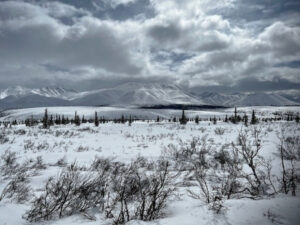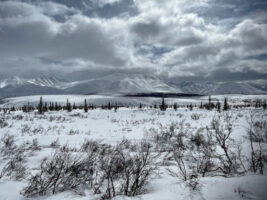DENALI’S SNOWIEST WINTER IN 99 YEARS OF RECORD KEEPING

Denali National Park is still melting out from its snowiest winter season in a century. The unusually heavy, lingering snow is affecting park wildlife.
Summer operations resumed on May 20, but park public affairs officer Sharon Stiteler says conditions along the Park Road are lagging behind the calendar.
“It definitely looks like winter when you’re out at about mile 10 and you’re looking into the tundra. I mean, it’s still very snow-covered,” she said.
The Park Service headquarters got 176 inches of snow this winter, besting the 1970-71 record of nearly 174 inches. As of May 15, there were still 33 inches of snow on the ground at Park headquarters — by far the most on record so late in the season.
But Stiteler says the onset of warmer temperatures this week has accelerated melting.
“There are more areas to be able to walk along the sides of the road, but we still have places where drifts are quite high or where we’ve had snow plowed. I’m 5 foot tall, and some of those drifts are higher than me,” she said.
Stiteler says the heavy snowpack dented some agency truck cabs and damaged a pedestrian bridge at Savage River. More important, it’s stressed wildlife, resulting in more animals on the Park Road this spring.
“Bears are using the road, as are moose,” she said. “Last week we did have a moose on the Park Road who gave birth to twins.”
Stiteler says the two calves have since died, noting that moose are generally very weak from the deep snow. But with so much still on the ground, it’s not clear how many moose have been dying.
“We’re anticipating more carcasses coming through as the snow melts, and we’re keeping a close eye on it — especially if some of those carcasses are along the Park Road or in areas we know visitors are going to frequent,” she said.
Meanwhile, a portion of the park road in the Sable Pass area has been closed to cyclists due to bear traffic.
“We’re having more and more bears show up along that stretch of roadway because that’s one of the spots where they can go to dig up roots right now and get food,” Stiteler said. “We don’t want to habituate the bears to bicycles, and we definitely don’t want anyone encountering a curious bear while they’re out bike riding.” KTOO
